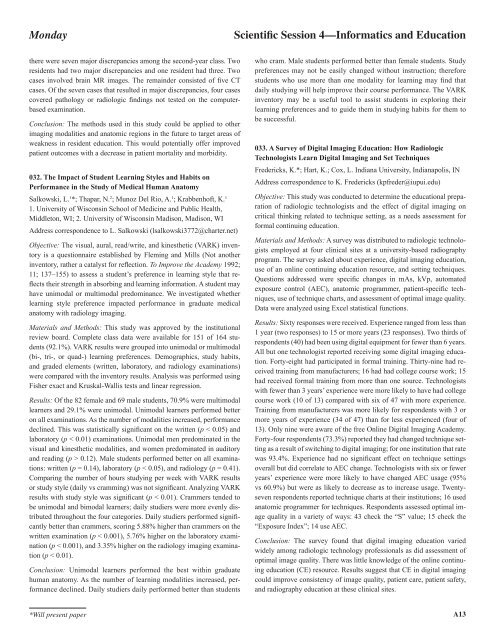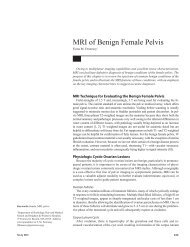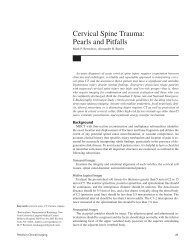Scientific Session 1 â Breast Imaging: Mammography
Scientific Session 1 â Breast Imaging: Mammography
Scientific Session 1 â Breast Imaging: Mammography
Create successful ePaper yourself
Turn your PDF publications into a flip-book with our unique Google optimized e-Paper software.
Monday<strong>Scientific</strong> <strong>Session</strong> 4—Informatics and Educationthere were seven major discrepancies among the second-year class. Tworesidents had two major discrepancies and one resident had three. Twocases involved brain MR images. The remainder consisted of five CTcases. Of the seven cases that resulted in major discrepancies, four casescovered pathology or radiologic findings not tested on the computerbasedexamination.Conclusion: The methods used in this study could be applied to otherimaging modalities and anatomic regions in the future to target areas ofweakness in resident education. This would potentially offer improvedpatient outcomes with a decrease in patient mortality and morbidity.032. The Impact of Student Learning Styles and Habits onPerformance in the Study of Medical Human AnatomySalkowski, L. 1 *; Thapar, N. 2 ; Munoz Del Rio, A. 1 ; Krabbenhoft, K. 11. University of Wisconsin School of Medicine and Public Health,Middleton, WI; 2. University of Wisconsin Madison, Madison, WIAddress correspondence to L. Salkowski (lsalkowski3772@charter.net)Objective: The visual, aural, read/write, and kinesthetic (VARK) inventoryis a questionnaire established by Fleming and Mills (Not anotherinventory, rather a catalyst for reflection. To Improve the Academy 1992;11; 137–155) to assess a student’s preference in learning style that reflectstheir strength in absorbing and learning information. A student mayhave unimodal or multimodal predominance. We investigated whetherlearning style preference impacted performance in graduate medicalanatomy with radiology imaging.Materials and Methods: This study was approved by the institutionalreview board. Complete class data were available for 151 of 164 students(92.1%). VARK results were grouped into unimodal or multimodal(bi-, tri-, or quad-) learning preferences. Demographics, study habits,and graded elements (written, laboratory, and radiology examinations)were compared with the inventory results. Analysis was performed usingFisher exact and Kruskal-Wallis tests and linear regression.Results: Of the 82 female and 69 male students, 70.9% were multimodallearners and 29.1% were unimodal. Unimodal learners performed betteron all examinations. As the number of modalities increased, performancedeclined. This was statistically significant on the written (p < 0.05) andlaboratory (p < 0.01) examinations. Unimodal men predominated in thevisual and kinesthetic modalities, and women predominated in auditoryand reading (p > 0.12). Male students performed better on all examinations:written (p = 0.14), laboratory (p < 0.05), and radiology (p = 0.41).Comparing the number of hours studying per week with VARK resultsor study style (daily vs cramming) was not significant. Analyzing VARKresults with study style was significant (p < 0.01). Crammers tended tobe unimodal and bimodal learners; daily studiers were more evenly distributedthroughout the four categories. Daily studiers performed significantlybetter than crammers, scoring 5.88% higher than crammers on thewritten examination (p < 0.001), 5.76% higher on the laboratory examination(p < 0.001), and 3.35% higher on the radiology imaging examination(p < 0.01).Conclusion: Unimodal learners performed the best within graduatehuman anatomy. As the number of learning modalities increased, performancedeclined. Daily studiers daily performed better than studentswho cram. Male students performed better than female students. Studypreferences may not be easily changed without instruction; thereforestudents who use more than one modality for learning may find thatdaily studying will help improve their course performance. The VARKinventory may be a useful tool to assist students in exploring theirlearning preferences and to guide them in studying habits for them tobe successful.033. A Survey of Digital <strong>Imaging</strong> Education: How RadiologicTechnologists Learn Digital <strong>Imaging</strong> and Set TechniquesFredericks, K.*; Hart, K.; Cox, L. Indiana University, Indianapolis, INAddress correspondence to K. Fredericks (kpfreder@iupui.edu)Objective: This study was conducted to determine the educational preparationof radiologic technologists and the effect of digital imaging oncritical thinking related to technique setting, as a needs assessment forformal continuing education.Materials and Methods: A survey was distributed to radiologic technologistsemployed at four clinical sites at a university-based radiographyprogram. The survey asked about experience, digital imaging education,use of an online continuing education resource, and setting techniques.Questions addressed were specific changes in mAs, kVp, automatedexposure control (AEC), anatomic programmer, patient-specific techniques,use of technique charts, and assessment of optimal image quality.Data were analyzed using Excel statistical functions.Results: Sixty responses were received. Experience ranged from less than1 year (two responses) to 15 or more years (23 responses). Two thirds ofrespondents (40) had been using digital equipment for fewer than 6 years.All but one technologist reported receiving some digital imaging education.Forty-eight had participated in formal training. Thirty-nine had receivedtraining from manufacturers; 16 had had college course work; 15had received formal training from more than one source. Technologistswith fewer than 3 years’ experience were more likely to have had collegecourse work (10 of 13) compared with six of 47 with more experience.Training from manufacturers was more likely for respondents with 3 ormore years of experience (34 of 47) than for less experienced (four of13). Only nine were aware of the free Online Digital <strong>Imaging</strong> Academy.Forty-four respondents (73.3%) reported they had changed technique settingas a result of switching to digital imaging; for one institution that ratewas 93.4%. Experience had no significant effect on technique settingsoverall but did correlate to AEC change. Technologists with six or feweryears’ experience were more likely to have changed AEC usage (95%vs 60.9%) but were as likely to decrease as to increase usage. Twentysevenrespondents reported technique charts at their institutions; 16 usedanatomic programmer for techniques. Respondents assessed optimal imagequality in a variety of ways: 43 check the “S” value; 15 check the“Exposure Index”; 14 use AEC.Conclusion: The survey found that digital imaging education variedwidely among radiologic technology professionals as did assessment ofoptimal image quality. There was little knowledge of the online continuingeducation (CE) resource. Results suggest that CE in digital imagingcould improve consistency of image quality, patient care, patient safety,and radiography education at these clinical sites.*Will present paperA13
















